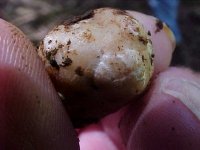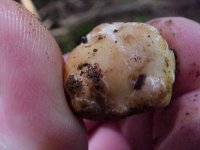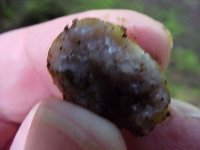Tuberale
Gold Member
and found these:
All photos are of Tuber gibbosum, also known as Oregon White truffle. First found in 1878 in California near San Francisco, not described until 1898 by Dr. Harkness; now known to be species specific (associated only) with Douglas-fir (Pseudotsuga menziesii).
These were uncovered with a potato rake at a tree farm near Oregon City, Oregon. Found several ounces, if not half a pound. Mostly mature, with transluscent chocolate brown interiors.
Truffles contain pheromones, which are also chemical sex-attractants. While you cannot smell pheromones, you react to them subconciously. An animal which digs and eats a truffles has this aroma concentrated in their salivary glands. For 3 days after consumption, everything eaten will taste/smell of truffles. In the case of Tuber gibbosum, the taste/smell is similar to a combination of dried morels (which are closely related to truffles), cheddar cheese, fresh-roasted hazelnuts, and garlic. (Usually I don't smell the garlic, but others insist it is there.
All photos are of Tuber gibbosum, also known as Oregon White truffle. First found in 1878 in California near San Francisco, not described until 1898 by Dr. Harkness; now known to be species specific (associated only) with Douglas-fir (Pseudotsuga menziesii).
These were uncovered with a potato rake at a tree farm near Oregon City, Oregon. Found several ounces, if not half a pound. Mostly mature, with transluscent chocolate brown interiors.
Truffles contain pheromones, which are also chemical sex-attractants. While you cannot smell pheromones, you react to them subconciously. An animal which digs and eats a truffles has this aroma concentrated in their salivary glands. For 3 days after consumption, everything eaten will taste/smell of truffles. In the case of Tuber gibbosum, the taste/smell is similar to a combination of dried morels (which are closely related to truffles), cheddar cheese, fresh-roasted hazelnuts, and garlic. (Usually I don't smell the garlic, but others insist it is there.












